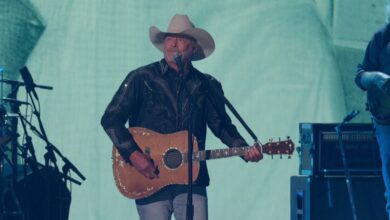The Ronettes’ “Be My Baby” Redefines Pop Sound and Female Vocal Power in 1963
Released in August 1963, “Be My Baby” by The Ronettes quickly became one of the most influential pop records of the 20th century. Written by Phil Spector, Ellie Greenwich, and Jeff Barry, and produced by Spector himself, the song was a sonic revelation that helped to define the “Wall of Sound” production technique. It peaked at No. 2 on the Billboard Hot 100 and remained on the charts for 13 weeks, heralding a new era in girl group pop and establishing The Ronettes as icons of their generation.
The Ronettes—led by Veronica “Ronnie” Bennett, with her sister Estelle Bennett and cousin Nedra Talley—emerged from New York’s Spanish Harlem with a distinctive look and sound. They began performing in the late 1950s, blending streetwise charm with sultry sophistication. With their towering beehive hairdos, dramatic eyeliner, and tight harmonies, The Ronettes quickly stood apart from other girl groups of the time. Ronnie’s voice in particular, raw yet angelic, had a power that few could match, giving the group an emotional edge that resonated across age and gender lines.
“Be My Baby” was born out of a fertile creative period for Spector, Greenwich, and Barry. Spector, obsessed with crafting the ultimate pop record, allegedly declared that “Be My Baby” would be the greatest song he’d ever produce. The lyrics, with their tender plea—“Be my, be my baby, my one and only baby”—were deceptively simple, yet emotionally rich. The song captured adolescent longing with poetic directness, making it immediately relatable. Legend has it that Spector heard the opening drum beat, performed by Hal Blaine, and was so struck by its power that he demanded it be the driving force of the record.
The recording sessions for “Be My Baby” took place at Gold Star Studios in Los Angeles and involved over 20 musicians, including members of the Wrecking Crew, an elite group of session players. Phil Spector’s production used a blend of guitars, strings, horns, and layered percussion to create a dense, echo-laden sound that enveloped Ronnie’s vocals. The track’s iconic “boom-ba-boom-BOOM” drumbeat, courtesy of Blaine, became one of the most recognizable intros in music history. Spector’s vision was cinematic, and with Ronnie’s magnetic vocal at the center, the final product was both intimate and monumental.
Critics and fans were quick to praise “Be My Baby.” Its emotional intensity, innovative production, and unforgettable melody made it an instant classic. The song’s influence was immediate and widespread. Brian Wilson of The Beach Boys famously called it the greatest pop record ever made and was so inspired that he wrote “Don’t Worry Baby” as a kind of response. In the UK, the song also became a top 10 hit, further cementing its transatlantic appeal. It wasn’t just a hit—it was a turning point.
“Be My Baby” changed the perception of what pop music could be. It elevated the girl group genre from teen novelty to high art. It showcased the power of the studio as an instrument in itself and demonstrated how emotional storytelling and sonic innovation could coexist. The song also broadened the audience for female-fronted acts, giving young women a new sense of identity and visibility in the male-dominated pop industry.
For The Ronettes, the song marked the pinnacle of their success. It opened the door to national TV appearances, a spot on the Rolling Stones’ first U.S. tour, and a permanent place in the cultural zeitgeist. Though they would release more hits, including “Baby, I Love You” and “Walking in the Rain,” “Be My Baby” became their signature anthem. Ronnie Bennett’s voice became synonymous with longing, strength, and beauty—a combination that defined 1960s girl-pop.
The song also left an indelible mark on other artists. It inspired countless imitations and tributes, from the lush harmonies of The Beach Boys to the retro stylings of Amy Winehouse and Lana Del Rey. Bruce Springsteen cited it as an influence, as did Billy Joel and Tom Petty. The track’s musical DNA can be found in dozens of songs across genres, reaffirming its place in the pop canon.
Over the years, “Be My Baby” has been covered by everyone from Andy Kim to John Lennon, who once produced a version of the song during his “Rock ‘n’ Roll” sessions. But few renditions could capture the ache and sweetness of the original. Ronnie’s vocal—equal parts innocence and defiance—was irreplaceable. Her phrasing, her breathy delivery, the slight cry in her tone—those were the ingredients that made the song immortal.
The release of “Be My Baby” came at a time of personal transformation for the group. Ronnie would go on to marry Phil Spector, a union that would later become notorious for its volatility. Yet in 1963, all was possibility. The Ronettes were at their most powerful and beloved, and the song’s success only amplified their celebrity. They had become the embodiment of teenage passion and heartbreak, wrapped in lush sound and velvet harmonies.
Today, “Be My Baby” continues to receive radio play, appears in countless film soundtracks—most famously in Dirty Dancing—and routinely places in “Greatest Songs of All Time” lists. Its relevance hasn’t waned with time; if anything, it’s grown. It represents not only a golden era in pop but a creative zenith in the art of record production.
From a technical standpoint, the song revolutionized how producers approached studio work. Phil Spector’s “Wall of Sound” would go on to influence everything from soul to punk to indie rock. It proved that pop could be ambitious, even orchestral, without losing its core appeal. And it confirmed that a single voice—placed just right in the mix—could convey more than any instrument ever could.
In later years, both the song and Ronnie Spector herself received numerous honors. “Be My Baby” was inducted into the Grammy Hall of Fame in 1999 and added to the National Recording Registry by the Library of Congress in 2006. Ronnie’s legacy was continually celebrated by generations of musicians who credited her with giving them permission to be emotional, powerful, and unapologetically feminine in their sound.
“Be My Baby” remains a masterclass in pop perfection. It wasn’t just a hit single—it was a cultural event, a technical achievement, and a vocal performance for the ages. More than 60 years later, its echo still lingers in the music we listen to today, a testament to its enduring power and the timeless magic of The Ronettes.



